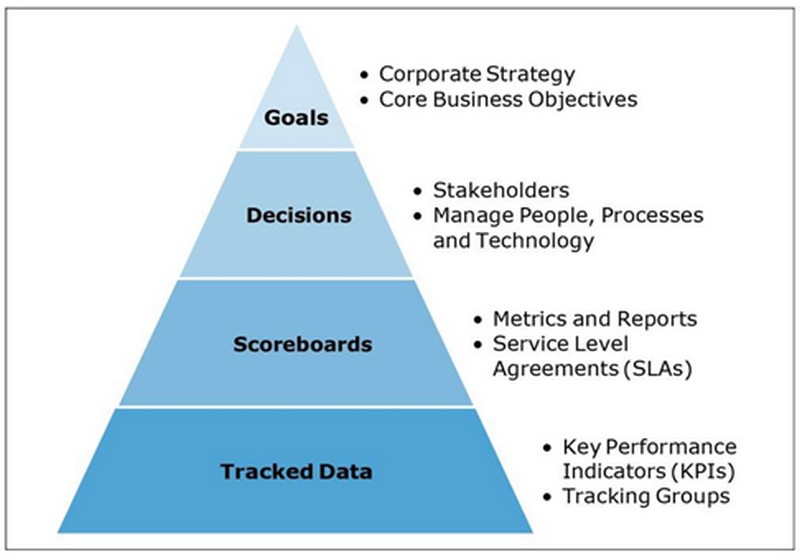Process Discovery Pyramid

Identifying key performance indicators
During process discovery, it is important to identify, define, and continuously validate the key performance indicators (KPIs). KPIs are the metrics used to measure process performance. Most managers are already comfortable with cost and time KPIs and typically report on activity-related cost or time metrics in some manner already. There is some confusion about the relationship between KPIs, metrics, SLAs, reports, and scoreboards.
A KPI is a quantifiable measurement that tells you what to measure and the unit of measure. A common KPI is cost. This KPI measures the cost of something, and the unit of measure might be currency. For a time KPI, the unit might be minutes, hours, or days.
If you have trouble identifying KPIs, go directly to the stakeholders and ask questions to solicit examples of decisions made by the stakeholders. Learn the frequency of those decisions and trace each decision to corporate strategy to validate the decisions. With a list of decisions, the necessary data (KPIs and SLAs) and presentation (scoreboards) begin to materialize.
Examples of KPIs include:
- Distance (kilometers)
- Time (hours and minutes)
- Fuel (litres)
- Temperature (degrees)
- Pressure (kg/sqm)
Identifying service level agreements
Many people are already familiar with some type of service level agreements (SLAs). As consumers we form expectations for a level of service that we receive. An SLA can also reflect the quality of service expected. For example, we would expect an emergency operator to quickly adapt to the caller’s language or transfer the caller to someone who can.
It is important to identify SLAs in your business processes early and validate them often with stakeholders, SMEs, and process participants. SLAs are used to manage your business process.
An SLA is a formally defined expectation for a level of performance. Generally, an SLA is an agreement between two parties wherein a service provider performs work for a customer or stakeholder. In business process modeling, an SLA can be an agreement to complete one step (activity) in the process by the due date. An SLA can span multiple activities and can be based on default or custom KPIs. SLAs empower you to establish a condition for one or more activities that triggers a consequence.
Examples of complex SLAs include:
“Oil life should not exceed 6000 kilometers. Oil life is measured in total kilometers since last oil change and a warning light is triggered at 5000 kilometers”.
“Engine speed should not exceed 7000 rpm. Engine speed is measured instantaneously and triggers a red light at 6000 rpm and kills the engine at 8000 rpm”.
Defining an SLA in IBM Business Process Manager involves creating a library artifact (SLA) and giving that artifact a meaningful name and description. An SLA includes a trigger and a consequence. The trigger by default reacts whenever the condition is violated and can be customized to respond to different trends and custom KPIs. The condition can accommodate custom logic that specifies a KPI and a threshold value to monitor as associated with specific activities.
Example:
- Name: Background Check Failure SLA
- Description: Monitor the frequency of failed background checks.
- Trigger: Violated 5% of the time over the last 5 days.
- Condition: The Background Check SLA for Background Check is equal to false.
- Consequence: Send email to hiring manager.
